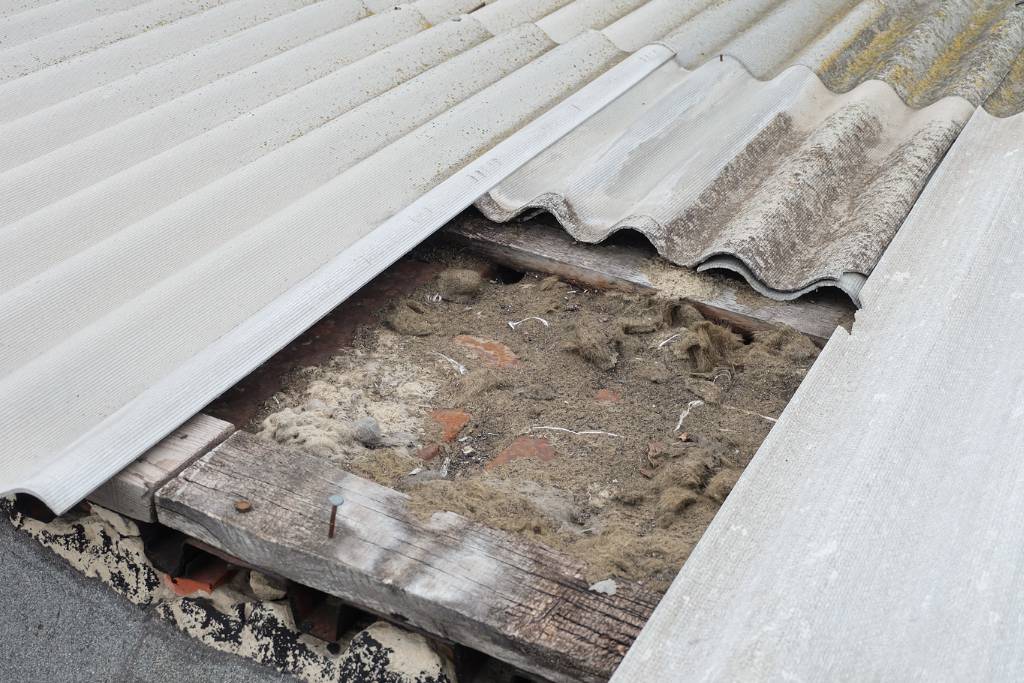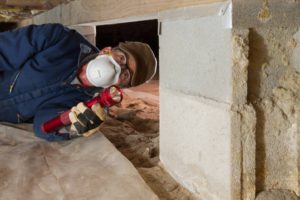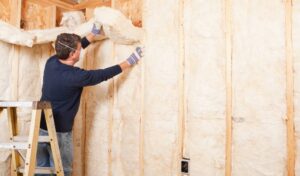Definition of asbestos insulation
Asbestos insulation refers to the use of asbestos fibers in insulating materials to provide heat and fire-resistant properties. Asbestos is a naturally occurring mineral that was commonly used in building materials and insulation due to its durability and resistance to heat and chemicals. However, it was later banned in many countries due to its health hazards, specifically its link to lung diseases such as mesothelioma and asbestosis. Despite the ban, many older buildings still contain asbestos insulation which poses a significant health risk if disturbed. It is important to identify and properly manage asbestos insulation to prevent exposure and ensure the safety of building occupants and workers. Understanding the definition and dangers of asbestos insulation is crucial for effective management and proper handling of materials containing this hazardous substance.
Importance of identifying asbestos insulation
The tell-tale signs of asbestos insulation include a gray or bluish color, as well as a fibrous or fluffy appearance. Homes built between the 1920s and 1980s are most likely to contain asbestos insulation. It is crucial to accurately identify the presence of asbestos insulation in homes for the safety of homeowners. Asbestos fibers can pose serious health risks when inhaled, leading to respiratory issues and even cancer. Therefore, it is essential to hire a licensed professional to inspect and test for the presence of asbestos insulation. These professionals have the necessary expertise and equipment to safely handle and dispose of any asbestos found in the home. Attempting to identify or remove asbestos insulation without the proper training and protective gear can release harmful fibers into the air, putting homeowners at risk. Therefore, it is imperative to enlist the help of a licensed professional to ensure the safety of all individuals involved.
What is Asbestos?
Asbestos is a mineral that has been widely used in construction and manufacturing due to its resistance to heat, electricity, and corrosion. It has been a popular material for insulation, roofing, flooring, and automotive parts. Despite its many useful properties, asbestos is highly toxic and can cause serious health problems when its fibers are inhaled. Due to its link to diseases like lung cancer, mesothelioma, and asbestosis, its use has been heavily regulated in many countries. Understanding what asbestos is and its potential risks is crucial for ensuring the safety of workers and the public when dealing with buildings or products that may contain this hazardous material.
Definition and characteristics of asbestos fibers
Asbestos fibers are naturally occurring minerals that have been widely used in various industrial applications due to their heat resistance, tensile strength, and insulating properties. This mineral can be found in rocks and soil, and due to its natural resistance to heat and chemicals, it was historically used in products such as insulation, roofing materials, and fireproofing. However, due to its detrimental health effects, the production and use of asbestos fibers have significantly decreased.
The physical properties of asbestos fibers include their thin, needle-like structure, which makes them easy to inhale. These fibers are also durable and resistant to heat, making them ideal for use in various materials. However, when inhaled, these fibers can cause serious health implications including lung cancer, mesothelioma, and asbestosis. The small size of the fibers allows them to penetrate deep into the lungs, resulting in long-term health issues.
Key characteristics of asbestos fibers include their natural occurrence in rocks and soil, their historical use in industrial applications, and their current production levels, which have decreased due to the associated health risks. The health implications of asbestos fibers are significant, and the understanding of their physical and chemical properties is crucial for managing the risks associated with exposure.

Common types of asbestos fibers
There are several common types of asbestos fibers, including chrysotile, amosite, crocidolite, and tremolite. Chrysotile, also known as white asbestos, is the most commonly used form of asbestos and is found in a wide variety of insulation materials. It is known for its flexibility and heat resistance. Amosite, also known as brown asbestos, is commonly found in insulation and cement products and is known for its high iron content. Crocidolite, also known as blue asbestos, is extremely heat resistant and was commonly used in insulation materials and spray-on coatings. Tremolite is a type of asbestos that is often found in vermiculite insulation, as well as in talc products.
These asbestos fibers are commonly found in insulation materials such as pipe insulation, HVAC duct insulation, and insulation wraps. Their characteristics include heat resistance, durability, and flexibility, making them desirable for use in insulation. However, it is important to note that exposure to these asbestos fibers can result in serious health risks, including lung disease and cancer. It is crucial to handle and remove asbestos-containing materials with care to prevent the release of these fibers into the air.
Health risks associated with asbestos exposure
Asbestos exposure poses serious health risks, including an increased risk of lung cancer, mesothelioma, and asbestosis. When asbestos-containing materials are disturbed, tiny asbestos fibers can become airborne and be inhaled or ingested. These fibers can then become lodged in the lungs or digestive system, leading to long-term health problems. Inhaling asbestos fibers can cause lung scarring, difficulty breathing, and an increased risk of lung cancer. Ingesting asbestos fibers can also lead to abdominal cancers, such as mesothelioma, as well as other related diseases.
If there is suspected exposure to asbestos, it is crucial to seek medical attention immediately. A healthcare professional can conduct tests to assess the extent of exposure and provide guidance on managing any potential health risks. Early detection and intervention are key to preventing the development of serious asbestos-related diseases. Therefore, it is vital to prioritize seeking medical attention to minimize the potential long-term health effects of asbestos exposure.
Identifying Asbestos Insulation
Asbestos insulation was once a popular material used in many homes and buildings for its fire-resistant and insulating properties. However, it was later discovered that asbestos exposure can lead to serious health risks, including lung disease and cancer. Identifying asbestos insulation in homes and buildings is crucial in order to assess the potential risk of exposure and to take appropriate action to safely remove or encapsulate it. In this section, we will discuss the common places to find asbestos insulation, how to identify it, and the steps to take if you suspect its presence. It is important to proceed with caution and seek professional help when dealing with asbestos insulation to ensure the safety of everyone involved.
Overview of asbestos-containing materials (ACMs)
Asbestos-containing insulation was commonly used in buildings and ships as a fireproofing and insulation material. There are two main types of asbestos-containing insulation: sprayed-on and pre-formed. Sprayed-on insulation, also known as “blown” insulation, was used in attics, walls, and ceilings, while pre-formed insulation was used in pipes, boilers, and other industrial equipment. Exposure to asbestos-containing insulation can lead to serious health risks, including lung cancer, mesothelioma, and asbestosis.
The dangers of asbestos insulation are significant, as exposure to asbestos fibers can lead to long-term health effects. When these fibers are disturbed, they can become airborne and easily inhaled, leading to potential health risks. Occupations such as construction workers, insulation installers, plumbers, electricians, and maintenance workers, as well as companies in the construction, shipbuilding, and manufacturing industries, were heavily exposed to asbestos through insulation materials. This exposure has led to an increased risk of asbestos-related diseases among these workers. It is crucial for individuals who have been exposed to asbestos-containing insulation to seek medical attention and take necessary precautions to prevent further exposure.
Asbestos pipe insulation
Asbestos pipe insulation was commonly used in buildings and industrial settings for its fire-resistant and insulating properties. It was often found wrapped around pipes to prevent heat loss and maintain temperature control. However, it was later discovered that asbestos-containing pipe insulation poses a significant health risk.
Identifying asbestos pipe insulation can be challenging as it is usually hidden behind walls or in hard-to-reach areas. Here are some tips to help identify asbestos pipe insulation:
- Age of the building: Asbestos-containing materials were commonly used in buildings constructed before the 1980s. If you suspect that your building or home was built before this time, there is a higher chance of asbestos insulation being present.
- Visual inspection: Look for pipes that are wrapped in a white or gray fibrous material. Asbestos pipe insulation is typically a white or gray color and has a fibrous texture. It may also have a corrugated appearance.
- Labeling: Some asbestos pipe insulation may have labels indicating that it contains asbestos. Look for labels that say “contains asbestos” or similar warnings.
- Professional inspection: If you are unsure about the presence of asbestos pipe insulation in your building, it is best to hire a professional asbestos inspector. They have the expertise and equipment to accurately identify asbestos-containing materials, including pipe insulation.
Steps to take if you suspect asbestos insulation
If you suspect the presence of asbestos insulation in your home or building, it is important to take the following steps:
- Do not disturb it: Asbestos becomes dangerous when its fibers are released into the air and inhaled. Avoid any activities that may disturb the insulation, such as drilling, cutting, or removing it.
- Inform others: If you suspect asbestos insulation in a building where others work or live, notify the appropriate authorities and occupants about your concerns. They should be made aware of the potential risks and take necessary precautions.
- Seek professional help: Contact a licensed asbestos abatement contractor to safely remove and dispose of the asbestos insulation. Do not attempt to remove or handle the insulation yourself, as this can release asbestos fibers into the air and increase the risk of exposure.
- Follow proper safety protocols: If you are exposed to asbestos insulation or have been in contact with it, seek medical attention immediately. Inform your healthcare provider about your potential asbestos exposure so they can take appropriate measures and monitor your health.
Signs of Asbestos Insulation in Other Areas
In addition to asbestos pipe insulation, asbestos-containing materials may be found in various other areas of a building. It is important to be aware of potential signs and take appropriate action if you suspect the presence of asbestos insulation. Here are some common areas where asbestos insulation may be found:
- Attic insulation: Asbestos was commonly used as attic insulation in the form of loose-fill insulation or vermiculite. If your attic insulation looks like small pebbles or has a silver-gray color, it may contain asbestos.
- Wall and ceiling insulation: Asbestos-containing materials may have been used as insulation behind walls and ceilings. Look for areas that have a textured or popcorn-like appearance, as these may contain asbestos.
- Floor tiles and linoleum: Asbestos was commonly used in vinyl floor tiles and linoleum products. If your flooring materials are old, brittle, or have a pattern that resembles small squares or hexagons, they may contain asbestos.
- Roofing materials: Asbestos-containing materials may have been used in roofing shingles, especially in older buildings. Look for roofing materials that have a textured appearance or are made of a material that resembles cement or slate, as these may contain asbestos.
- HVAC systems: Asbestos insulation may be found in HVAC ducts, pipes, and boilers. Look for insulation that has a fibrous texture or a grayish color.
- Electrical wiring: Asbestos-containing materials may have been used as insulation for electrical wires. If you notice cloth-like or braided insulation around electrical wires, it may contain asbestos.
- Vermiculite insulation: Vermiculite is a mineral commonly used as insulation in buildings. If your insulation looks like small, shiny flakes or has a silver-gray color, it may contain asbestos.
To identify asbestos insulation in these areas, it is recommended to hire a professional asbestos inspector who can safely collect samples and have them tested for asbestos content. This will provide definitive confirmation of whether or not asbestos is present in the insulation.
Remember, it is crucial to exercise caution and prioritize safety when dealing with asbestos insulation. Always follow proper procedures and seek professional assistance to ensure the safe removal and disposal of any asbestos-containing materials.

Frequently Asked Questions
What are steam pipes and why are they insulated?
Steam pipes are pipes used for transporting steam in various systems such as in commercial buildings or industrial settings. Insulation is added to steam pipes to prevent heat loss and to maintain proper temperature and energy efficiency.
What are the types of insulation used for steam pipes?
Common types of insulation used for steam pipes include mineral wool, asbestos paper, and asbestos block insulation.
Is asbestos insulation commonly found in commercial buildings?
Yes, asbestos insulation was commonly used in commercial buildings before its dangers were discovered. It was prized for its heat resistance and durability.
What is considered a safe level of asbestos exposure?
There is no safe level of asbestos exposure. Even low levels of exposure can increase the risk of developing asbestos-related diseases, such as lung cancer or mesothelioma.
What is tremolite asbestos and where can it be found?
Tremolite asbestos is a type of asbestos fiber that can be found in some insulation materials, including loose insulation. It is a highly toxic form of asbestos.
How are microscopic fibers from asbestos insulation harmful?
When disturbed or damaged, asbestos insulation can release microscopic fibers into the air. Inhalation of these fibers can lead to serious health problems when they accumulate in the lungs.
Is mineral wool a safe alternative to asbestos insulation?
Yes, mineral wool is a safer alternative to asbestos insulation. It is made from natural or synthetic fibers and does not pose the same health risks associated with asbestos.
How should asbestos insulation be properly removed?
Asbestos removal should be performed by licensed professionals who have experience and training in handling asbestos-containing materials. Special precautions and procedures are necessary to minimize the release of asbestos fibers during removal.
Note: Asbestos-related topics require professional guidance and adherence to local regulations. It is advisable to consult experts in asbestos removal for specific advice and information.
Need a professional attic inspection? Call Attic Crew today for all of you insulation needs!




